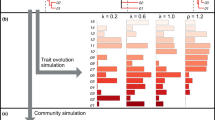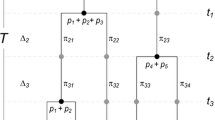Abstract
Recently, dated phylogenies have been increasingly used for ecological studies on community structure and conservation planning. There is, however, a major impediment to a systematic application of phylogenetic methods in ecology: reliable phylogenies with time-calibrated branch lengths are lacking for a large number of taxonomic groups and this condition is likely to continue for a long time. A solution for this problem consists in using undated phylogenies or taxonomic hierarchies as proxies for dated phylogenies. Nonetheless, little is known on the potential loss of information of these approaches compared to studies using dated phylogenies with time-calibrated branch lengths. The aim of this study is to ask how the use of undated phylogenies and taxonomic hierarchies biases a very simple measure of diversity, the mean pairwise phylogenetic distance between community species, compared to the diversity of dated phylogenies derived from the freely available software Phylomatic. This is illustrated with three sets of data on plant species sampled at different scales. Our results show that: (1) surprisingly, the diversity computed from dated phylogenies derived from Phylomatic is more strongly related to the diversity computed from taxonomic hierarchies than to the diversity computed from undated phylogenies, while (2) less surprisingly, the strength of this relationship increases if we consider only angiosperm species.

Similar content being viewed by others
References
APG (2009) An update of the angiosperm phylogeny group classification for the orders and families of flowering plants: APG III. Bot J Linn Soc 161:105–121
Barker GM (2002) Phylogenetic diversity: a quantitative framework for measurement of priority and achievement in biodiversity conservation. Biol J Linn Soc 76:165–194
Boero F (2010) The study of species in the era of biodiversity: a tale of stupidity. Diversity 2:115–126
Buerki S, Forest F, Salamin N, Alvarez N (2011) Comparative performance of supertree algorithms in large data sets using the soapberry family (Sapindaceae) as a case study. Syst Biol 60:32–44
Cavender-Bares J, Hozak KH, Fine PVA, Kembel SW (2009) The merging of community ecology and phylogenetic biology. Ecol Lett 12:693–715
Chiarucci A, Bacaro G, Rocchini D (2008a) Quantifying plant species diversity in a Natura 2000 network: old ideas and new proposals. Biol Conserv 141:2608–2618
Chiarucci A, Bacaro G, Vannini A, Rocchini D (2008b) Quantifying species richness at multiple spatial scales in a Natura 2000 network. Community Ecol 9:185–192
Crozier RH (1997) Preserving the information content of species: genetic diversity, phylogeny and conservation worth. Annu Rev Ecol Syst 24:243–268
Crozier RH, Dunnett LJ, Agapow PM (2005) Phylogenetic biodiversity assessment based on systematic nomenclature. Evol Bioinform Online 1:11–36
Faith DP (1992) Conservation evaluation and phylogenic diversity. Biol Conserv 61:1–10
Forest F, Grenyer R, Rouget M, Davies TJ, Cowling RM, Faith DP, Balmford A, Manning JC, Proches S, van der Bank M, Reeves G, Hedderson TAJ, Savolainen V (2007) Preserving the evolutionary potential of floras in biodiversity hotspots. Nature 445:757–760
Gerhold P, Pärtel M, Liira J, Zobel K, Prinzing A (2008) Phylogenetic structure of local communities predicts the size of the regional species pool. J Ecol 96:709–712
Godefroid S (2001) Temporal analysis of the Brussels flora as indicator for changing environmental quality. Landsc Urban Plan 52:203–224
Harper JL, Hawksworth DL (1995) Preface. In: Hawksworth DL (ed) Biodiversity: measurements and estimation. Chapman and Hall, London, pp 5–12
Kraft NJB, Ackerly DD (2010) Functional trait and phylogenetic tests of community assembly across spatial scales in an Amazonian forest. Ecol Monogr 80:401–422
Kress WJ, Erickson DL, Jones FA, Swenson NG, Perez R, Sanjur O, Bermingham E (2009) Plant DNA barcodes and a community phylogeny of a tropical forest dynamics plot in Panama. Proc Natl Acad Sci USA 106:18621–18626
Kress WJ, Erickson DL, Swenson NG, Thompson J, Uriarte M, Zimmerman JK (2010) Advances in the use of DNA barcodes to build a community phylogeny for tropical trees in a Puerto Rican forest dynamics plot. PLoS ONE 5:e15409
Mace GM, Gittleman JL, Purvis A (2003) Preserving the tree of life. Science 300:1707–1709
Ricotta C, Di Nepi M, Guglietta D, Celesti-Grapow L (2008a) Exploring taxonomic filtering in urban environments. J Veg Sci 19:229–238
Ricotta C, Godefroid S, Celesti-Grapow L (2008b) Common species have lower taxonomic diversity: evidence from the urban floras of Brussels and Rome. Divers Distrib 14:530–537
Ricotta C, LaSorte FA, Pyšek P, Rapson GL, Celesti-Grapow L, Thompson K (2009) Phyloecology of urban alien floras. J Ecol 97:1243–1251
Ricotta C, Godefroid S, Rocchini D (2010) Invasiveness of alien plants in Brussels is related to their phylogenetic similarity to native species. Divers Distrib 16:655–662
Rodrigues ASL, Gaston KJ (2002) Maximising phylogenetic diversity in the selection of networks of conservation areas. Biol Conserv 105:103–111
Soltis PS, Soltis DE (2004) The origin and diversification of angiosperms. Am J Bot 91:1614–1626
Stewart WN, Rothwell GW (1993) Paleobotany and the evolution of plants. Cambridge University Press, Cambridge
Strauss SY, Webb CO, Salamin N (2006) Exotic taxa less related to native species are more invasive. Proc Natl Acad Sci USA 103:5841–5845
Swenson NG (2009) Phylogenetic resolution and quantifying the phylogenetic diversity and dispersion of communities. PLoS ONE 4:e4390
Swenson NG, Enquist BJ (2009) Opposing assembly mechanisms in a Neotropical dry forest: implications for phylogenetic and functional community ecology. Ecology 90:2161–2170
Thompson K, Petchey OL, Askew AP, Dunnett NP, Beckerman AP, Willis AJ (2010) Little evidence for limiting similarity in a long-term study of a roadside plant community. J Ecol 98:480–487
Warwick RM, Clarke KR (1994) New ‘biodiversity’ measures reveal a decrease in taxonomic distinctness with increasing stress. Mar Ecol Prog Ser 129:301–305
Warwick RM, Clarke KR (2001) Practical measures of marine biodiversity based on relatedness of species. Oceanogr Mar Biol Annu Rev 39:207–231
Webb CO (2000) Exploring the phylogenetic structure of ecological communities: an example for rain forest trees. Am Nat 156:145–155
Webb CO, Donoghue MJ (2005) Phylomatic: tree assembly for applied phylogenetics. Mol Ecol Notes 5:181–183
Webb CO, Ackerly DD, McPeek MA, Donoghue MJ (2002) Phylogenies and community ecology. Annu Rev Ecol Syst 33:475–505
Webb CO, Ackerly DD, Kembel SW (2008) Phylocom: software for the analysis of phylogenetic community structure and trait evolution. Bioinformatics 24:2098–2100
Wikstrom N, Savolainen V, Chase MW (2001) Evolution of angiosperms: calibrating the family tree. Proc R Soc Lond B 268:2211–2220
Acknowledgments
We thank the anonymous referees for their very constructive comments on a previous version of our paper. Data collection in Brussels (dataset A) was financed by the Brussels Institute for Environment Management (IBGE-BIM) in the framework of the research project ‘Information and survey network on the biodiversity in Brussels’. G.B. is grateful to Alessandro Chiarucci for providing useful ideas and support during the MOBISIC data collection phase (dataset C). G.B. also warmly acknowledges the valuable support of Elisa Baragatti, Giulia Bennati, Domenico Bernardini, Marta Chincarini, Alessia Delli Bove, Francesco Geri, Sara Ghisleni, Sara Landi, Lia Pignotti, Duccio Rocchini, Elisa Santi, Mauro Taormina, Emanuele Vallone and Arianna Vannini during data collection and plant identification.
Author information
Authors and Affiliations
Corresponding author
Additional information
Communicated by Melinda Smith.
Rights and permissions
About this article
Cite this article
Ricotta, C., Bacaro, G., Marignani, M. et al. Computing diversity from dated phylogenies and taxonomic hierarchies: does it make a difference to the conclusions?. Oecologia 170, 501–506 (2012). https://doi.org/10.1007/s00442-012-2318-8
Received:
Accepted:
Published:
Issue Date:
DOI: https://doi.org/10.1007/s00442-012-2318-8




